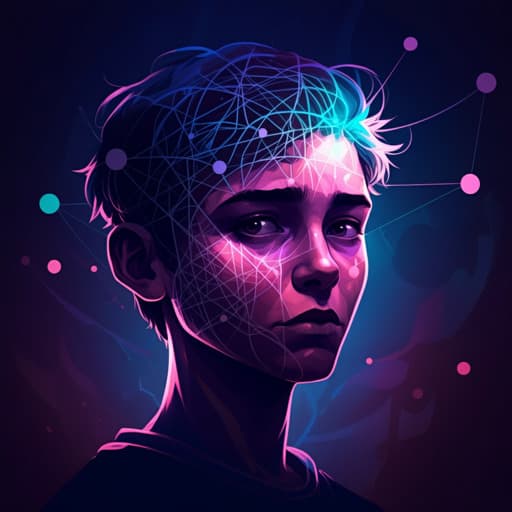
Psychology
Anxiety and depression amongst youth as adverse effects of using social media: A Review
M. Prasad, M. A. Souabni, et al.
This review delves into how social media use can impact the mental well-being of youth, highlighting key engagement patterns linked to anxiety and depression. Conducted by a team of researchers including MDSakshi Prasad and MDSara Ait Souabni, it calls for urgent conversations between parents and physicians regarding social media exposure.
~3 min • Beginner • English
Introduction
The review addresses whether social media use contributes to the development or exacerbation of depression and anxiety among adolescents and young adults (approximately 12–26 years). The context is the widespread adoption of social media, changing norms of interaction, and concurrent increases in youth mental health problems and suicidality, particularly among early adolescent girls. Adolescence and early adulthood are critical developmental periods with heightened vulnerability to anxiety and depression. The purpose is to synthesize evidence linking social media use—beyond time spent—to specific usage patterns that may affect mental health, and to outline implications and research needs.
Literature Review
The review synthesizes studies examining the association between social media use and depressive/anxiety symptoms, emphasizing that the relationship extends beyond frequency or duration to usage patterns and user factors. Passive use (e.g., browsing without interaction) relates to loneliness, low mood, and self-comparison; exposure to self-harm content and suicide communication can normalize and reinforce self-harm behaviors, with documented contagion effects (e.g., Blue Whale Challenge). Media multitasking correlates with higher depression and social anxiety and poorer productivity. Appearance-based activities (filters, editing) are linked to body dissatisfaction, eating pathology, and psychological distress. Night-time use associates with poorer sleep and predicts depression and anxiety, though emotional investment may be a stronger predictor. Disaster awareness via social feeds (pandemics, conflicts) is associated with heightened stress, anxiety, and depression; COVID-19 related social media exposure aggravated symptoms in several studies. Active use patterns also show mixed effects: while some active engagement may be protective, sexting—especially unwanted/coerced or non-consensual dissemination—relates to depression, anxiety, and self-harm, with gender and demographic moderators. Cyberbullying and online ethnic discrimination are strongly associated with depressive and anxiety symptoms; female victims may be at higher risk, while parental/social support and growth mindset can be protective. Emotional investment in social media is consistently associated with anxiety, depression, and low self-esteem, consistent with the dualistic model of passion (harmonious vs obsessive). Problematic social media use (PSMU), characterized by compulsive use and impairment, predicts depression, anxiety, stress, low self-esteem, and may co-occur with other addictions and certain personality traits. Areas with limited evidence but theoretical relevance include social gaming, access to nudity/pornography via platforms, compulsive online shopping driven by social media advertising, and cyberchondria. Experimental and intervention studies suggest social media–delivered or web-based interventions (peer support sites, counseling, single-session interventions) can reduce anxiety/depression symptoms and are acceptable to youth.
Methodology
Narrative review guided by SANRA criteria. On 23 December 2022, the authors searched Medline for all-time publications using combinations of terms including: social media and depression (58,088 results), social media and anxiety (57,139), social media and self-harm (25,301), problematic social media use and depression (10,494), problematic social media use and anxiety (10,400), social media and suicidality (8,776), cyberchondria (418), fear of missing out (250), nomophobia (245), social media and body dissatisfaction (5,319), social gaming and depression (5,475), sexting (577), cyberbullying (2,442). Abstracts were screened for studies examining social media use in relation to depression and anxiety among youth (ages 12–26). Seventy-seven full-text studies and reviews relevant to the objectives were included and cited. Selection emphasized relevance to patterns of social media engagement and mental health outcomes.
Key Findings
- Overall association: Social media use is frequently associated with higher depressive and anxiety symptoms among youth; the relationship depends on how platforms are used, not just time spent.
- Passive use: Passive browsing correlates with loneliness, negative self-evaluation, and low mood; exposure to self-harm/suicide content and suicide communication can normalize and amplify self-harm behaviors, with documented contagion.
- Media multitasking: Associated with higher depression and social anxiety and poorer cognitive performance, potentially contributing to guilt and worthlessness.
- Appearance-based activities: Preoccupation with online appearance and edited/idealized images links to body dissatisfaction, eating problems, depression, anxiety, and appearance rejection sensitivity.
- Night-time media use: Predicts poorer sleep and is associated with depression and anxiety; emotional investment may be a stronger predictor than timing alone.
- Disaster awareness via feeds: Repeated exposure to crises (e.g., pandemics) via social media correlates with increased stress, anxiety, and depressive symptoms (e.g., COVID-19 studies).
- Active use: While some active engagement may be protective, sexting—particularly unwanted/coerced or non-consensual—relates to anxiety, depression, and self-harm; demographic moderators exist (e.g., higher risk among girls for certain outcomes). Cyberbullying and online ethnic discrimination are robustly linked to depression/anxiety; females may be more vulnerable; social/parental support and growth mindset are protective.
- Emotional investment: High emotional investment/obsessive passion for social media strongly relates to anxiety, depression, and low self-esteem.
- Problematic social media use (PSMU): Predicts depression, anxiety, stress, and low self-esteem; associated with social assurance needs and may co-occur with substance use and maladaptive personality traits.
- Interventions: Web/social media–based interventions (peer-support websites, online counseling, single-session interventions) significantly reduce depressive/anxiety symptoms and are acceptable to youth.
- Scope: Initial search identified 184,924 articles; 77 studies were included focusing on youth 12–26 years.
Discussion
Findings indicate that youth mental health risks from social media are driven by specific engagement patterns and contextual factors rather than mere exposure time. Passive consumption, appearance-focused activities, night-time use, disaster-focused feeds, and emotionally obsessive engagement may heighten vulnerability by promoting unfavorable social comparison, sleep disruption, cognitive overload, and stress reactivity. Active harms such as cyberbullying, online ethnic discrimination, and coerced sexting exacerbate risk for depression, anxiety, and self-harm, with gender and social context moderating effects. Conversely, protective influences such as parental and social support and growth mindset can buffer risks. Importantly, social media and web platforms also enable scalable, acceptable mental health interventions that have shown symptom reductions in controlled studies, suggesting platforms can be part of the solution when used intentionally. Clinically, integrating routine assessment of social media exposure and patterns in youth care, guiding families on healthy practices (limits, sleep hygiene, content monitoring appropriate to development), and encouraging offline social skills may mitigate risks. The field requires longitudinal and mechanistic research to clarify causal pathways and moderators to inform targeted prevention and intervention strategies.
Conclusion
Social media use contributes to depression and anxiety among youth, with risk concentrated in specific engagement patterns (e.g., passive consumption, appearance focus, night-time use), harmful online interactions (cyberbullying, coerced sexting, discrimination), high emotional investment, and problematic use. Understanding these pathways can guide targeted, youth-centered interventions and clinical guidance. Evidence also supports the promise of social media–delivered interventions to reduce symptoms. Future research should establish causality, identify moderators/mediators, and refine interventions tailored to usage patterns and developmental needs.
Limitations
- Much of the existing literature is cross-sectional, limiting causal inference about whether social media induces, exacerbates, or is a consequence of depression and anxiety.
- Heterogeneity and lack of universally validated measures for active vs passive use complicate comparisons across studies.
- Limited and methodologically weak evidence in certain domains (e.g., social gaming as distinct from general gaming disorder, pornography/nudity access via social media, social media–driven compulsive shopping, cyberchondria) constrains conclusions.
- Problematic social media use lacks formal diagnostic status and standardized criteria in DSM-5, affecting study consistency.
- The review is narrative rather than systematic, which may introduce selection bias despite structured searching.
Related Publications
Explore these studies to deepen your understanding of the subject.







